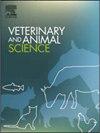A study on subcutaneous infection model of colibacillosis in broilers: Selected immunological and hematological aspects
IF 1.9
Q2 AGRICULTURE, DAIRY & ANIMAL SCIENCE
引用次数: 0
Abstract
Colibacillosis is still a major challenge to poultry industry. This study examined selected immune and hematological features of broilers experimentally infected with E. coli via subcutaneous (sc) route. Fifty-one 5-week-old chickens were randomly assigned to three groups: two controls (NC and SCC) and one experimental (SC) group. The SC group was inoculated by O2 E. coli suspension via sc route in the inguinal region. Three days after inoculation, blood sampling was performed. Bacterial count of liver was determined. Histopathological samples of liver, lung, spleen, thymus, and bursa were also collected. Serum total protein and globulin significantly increased in birds of SC group as compared to control birds (P < 0.05). Birds in SC group also showed decreased albumin/globulin ratio. Serum levels of IL-6, IL-10, and IFN-γ remained statistically the same among groups. Lymphocytosis, monocytosis, thrombocytosis and heterophilia were present in SC group. Heterophils/lymphocytes ratio increased in SC birds. Left shift was observed in SC group with cells showing vacuolated cytoplasm that contained toxic granules. Histologically, lung involvement was less severe than liver. Lymphoid depletion was present in all examined lymphoid organs. E. coli growth was observed in liver samples from SC group but not in control birds. In conclusion, using sc route for induction of colibacillosis was associated with a systemic inflammatory response in broilers and histopathological lesions of thymus, bursa, and spleen three days post-infection. It seems that detection of changes in serum cytokine levels (IL-6, IL-10, and IFN-γ) should be performed in earlier hours of the disease in this model.
肉鸡大肠杆菌病皮下感染模型研究:免疫学和血液学方面的若干问题
大肠杆菌病仍是家禽业面临的一大挑战。本研究对通过皮下注射(sc)途径实验性感染大肠杆菌的肉鸡的免疫和血液学特征进行了研究。51 只 5 周龄的鸡被随机分配到三个组:两个对照组(NC 组和 SCC 组)和一个实验组(SC 组)。SC 组通过 sc 途径在腹股沟区域接种 O2 大肠杆菌悬浮液。接种三天后抽血。测定肝脏细菌数。还采集了肝、肺、脾、胸腺和法氏囊的组织病理学样本。与对照组鸟类相比,SC 组鸟类的血清总蛋白和球蛋白明显增加(P < 0.05)。SC组鸟类的白蛋白/球蛋白比率也有所下降。各组血清中的 IL-6、IL-10 和 IFN-γ 水平在统计学上保持不变。SC组出现淋巴细胞增多、单核细胞增多、血小板增多和嗜异性细胞增多。嗜异性细胞/淋巴细胞比率在 SC 组中升高。SC组观察到细胞左移,细胞胞质呈空泡状,含有毒性颗粒。从组织学角度看,肺部受累的程度不如肝脏严重。所有受检淋巴器官均出现淋巴细胞耗竭。在 SC 组鸟类的肝脏样本中观察到大肠杆菌生长,而在对照组鸟类的肝脏样本中未观察到大肠杆菌生长。总之,用 sc 途径诱导大肠杆菌病与肉鸡的全身炎症反应以及感染后三天胸腺、法氏囊和脾脏的组织病理学病变有关。在该模型中,似乎应在发病初期检测血清细胞因子水平(IL-6、IL-10 和 IFN-γ)的变化。
本文章由计算机程序翻译,如有差异,请以英文原文为准。
求助全文
约1分钟内获得全文
求助全文
来源期刊

Veterinary and Animal Science
Veterinary-Veterinary (all)
CiteScore
3.50
自引率
0.00%
发文量
43
审稿时长
47 days
 求助内容:
求助内容: 应助结果提醒方式:
应助结果提醒方式:


